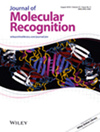Journal of Molecular Recognition (JMR) publishes original research papers and reviews describing molecular recognition phenomena in biology. Molecular recognition refers to the non-covalent specific interaction between two or more biological molecules exemplified by receptor-ligand antigen-antibody DNA-protein sugar-lectin and many other interactions. Biomolecular interactions are studied both at the structural level in terms of atomic coordinates and at the functional level in terms of kinetic and equilibrium binding constants. The journal will focus on studies that aim to achieve a complete description of recognition sites in terms of the structure dynamics and activity of biomolecules. JMR will provide a forum for research papers in the field of quantitative biomolecular interaction analysis using biosensors and other solution or surface-mediated experimental techniques including microcalorimetry. Since the understanding of molecular recognition at a microscopic level can be aided by theoretical approaches including electrostatic analysis and molecular dynamics and free energy simulations these aspects will also be covered. In addition submission of manuscripts related to the application of other instrumental methods such as HPLC LC-MS CE-MS employed in the elucidation of the biophysical basis of the pathways of molecular recognition between interacting biological molecules are encouraged. The design synthesis and application of structural or topological mimics of naturally occurring molecules in the characterisation of molecular recognition processes represents a further aspect encompassed by the Journal. These technologies in conjunction with crystallography NMR and site directed mutagenesis are providing new insights into the correlation between atomic structure and binding energy and pave the way to improved computer simulation docking and molecular design of biologically active molecules. JMR will also publish articles on the applications of chemically and biologically generated molecular libraries to the study of biomolecular interactions and the creation of novel functions.
